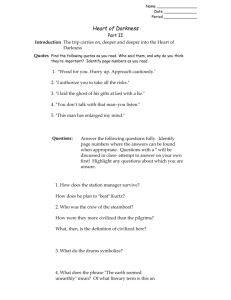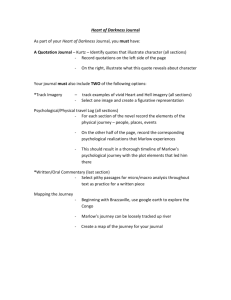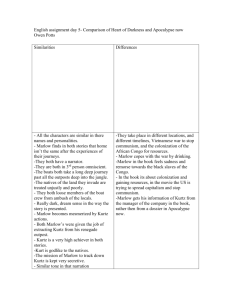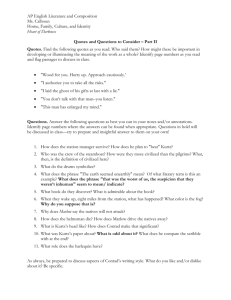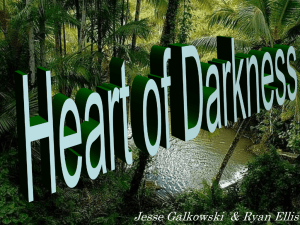Heart of Darkness, Joseph Conrad - New Paltz Central School District
advertisement
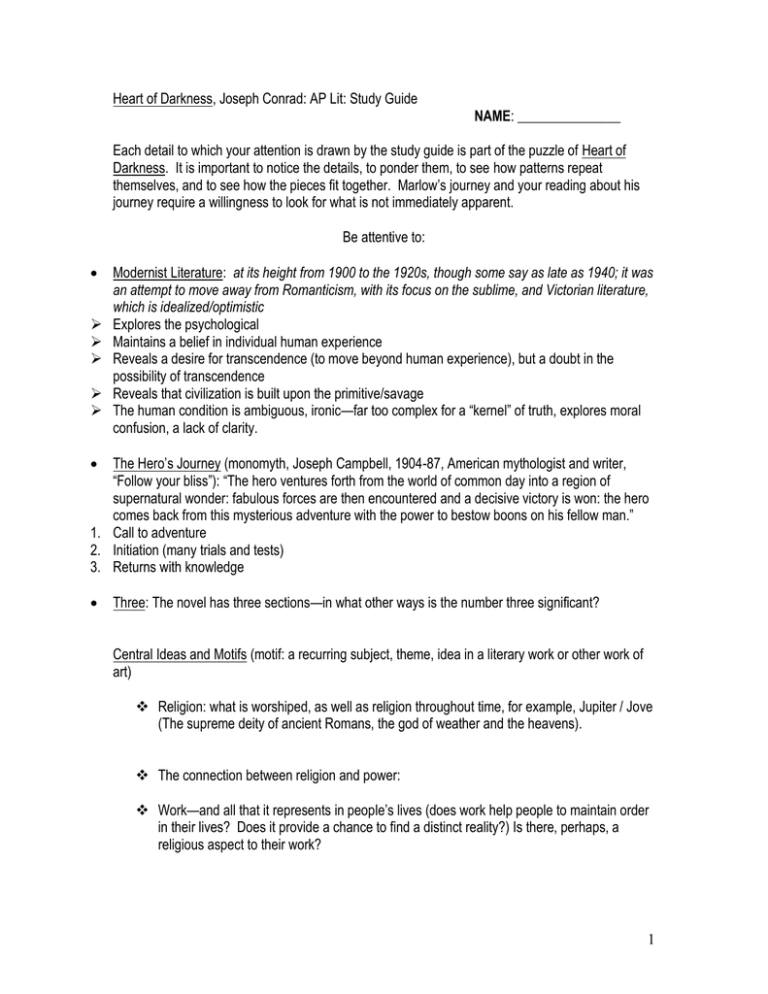
Heart of Darkness, Joseph Conrad: AP Lit: Study Guide NAME: _______________ Each detail to which your attention is drawn by the study guide is part of the puzzle of Heart of Darkness. It is important to notice the details, to ponder them, to see how patterns repeat themselves, and to see how the pieces fit together. Marlow’s journey and your reading about his journey require a willingness to look for what is not immediately apparent. Be attentive to: Modernist Literature: at its height from 1900 to the 1920s, though some say as late as 1940; it was an attempt to move away from Romanticism, with its focus on the sublime, and Victorian literature, which is idealized/optimistic Explores the psychological Maintains a belief in individual human experience Reveals a desire for transcendence (to move beyond human experience), but a doubt in the possibility of transcendence Reveals that civilization is built upon the primitive/savage The human condition is ambiguous, ironic—far too complex for a “kernel” of truth, explores moral confusion, a lack of clarity. The Hero’s Journey (monomyth, Joseph Campbell, 1904-87, American mythologist and writer, “Follow your bliss”): “The hero ventures forth from the world of common day into a region of supernatural wonder: fabulous forces are then encountered and a decisive victory is won: the hero comes back from this mysterious adventure with the power to bestow boons on his fellow man.” 1. Call to adventure 2. Initiation (many trials and tests) 3. Returns with knowledge Three: The novel has three sections—in what other ways is the number three significant? Central Ideas and Motifs (motif: a recurring subject, theme, idea in a literary work or other work of art) Religion: what is worshiped, as well as religion throughout time, for example, Jupiter / Jove (The supreme deity of ancient Romans, the god of weather and the heavens). The connection between religion and power: Work—and all that it represents in people’s lives (does work help people to maintain order in their lives? Does it provide a chance to find a distinct reality?) Is there, perhaps, a religious aspect to their work? 1 Women: Rivers: Thames, Brussels, Congo Blindness (and fog): Light and Dark Imagery: Interior vs. exterior: Appearance vs. reality Dreams and nightmares: The hypocrisy of Imperialism: Section I: A. The Thames Setting: 1. Notice the descriptions of the tide, the river, and the ships. Who are the friends of Marlow who are on board the Nellie with him? What theme is introduced by their various occupations? 2. Marlow is like the setting of the river—the “brooding” nature he describes and his sitting like an “idol.” What is suggested by his sitting position and his state of mind? 3. As the ship sits at anchor on the Thames, Marlow is reminded of the past. The Thames is a “waterway…to the utmost ends of the earth”; the river represents the “spirit of the past.” Why has the Thames been “one of the dark places”? What is the significance of the reference to the invasions of the Romans? 2 4. What does Marlow mean by his comments on the telling of a story, the “kernel” and “the misty halo”? 5. What effect is created by Marlow’s interruption into the quiet, “brooding” scene aboard the Nellie? The narrative technique in the novel is like a series of Chinese boxes—Conrad the author, the unnamed narrator who tells us about Marlow, Marlow who describes his journey and about Kurtz, the voice of Kurtz (the innermost voice). What thematic and narrative purposes might be served by this layer on layer of narrative voices? B. Preparation for the Journey: 1. The idea of travel is emphasized from the very beginning (and, of course, throughout the novel)—and maps are emphasized several times in this early section. Consider his background with maps—and how the river is described. 2. In what way do “the women” help Marlow? What is Marlow’s attitude toward women? Notice that even though his aunt gets the job for him, he observes near the end that she is like other women, “out of touch with truth.” What does he mean—what does Marlow see as the truth— and who speaks it? 3. Who is Fresleven? 4. Marlow builds a series of images to describe the company office, consider The narrow street: The two women knitting: The color black: 3 The doctor: who prophesies madness and his theory of what is “scientifically interesting”: 5. An archetype is defined as “the original pattern or model from which all things of the same kind are copied or on which they are based; a model or first form; prototype” (dictionary.com). There are various archetypes in literature, some of which are represented in Conrad’s Heart of Darkness. Describe the following, as illustrated in Section I of the novel The imposter character type (consider the theme of exterior vs. interior): The hero’s journey: C. The Journey: The First Stage 1. 2. As Marlow rides down the coast of Africa on the French steamer, he is struck by the appearance of the coastline, the brightness of the sun, the ridiculous shooting into the jungle by the warship, the mixture of death and trade. What feelings about Africa, about Europeans, and about the job he is about to assume are aroused by the beginning of his journey? What river does he journey upward? 3. Describe what Marlow sees at the First Station, the Outer Station. What is signified by the abandoned machinery, the chaotic appearance, the suffering of the slaves? What is the “devil of rapacious and pitiless folly”? 4. In the grove of death Marlow sees a slave wearing a bit of “white worsted” about his neck. How does that detail, the white twisted thread around the neck of this young African man, connect to the European invasion of Africa? 5. Describe the Chief Accountant. Why does Marlow notice him—and what does he represent? Is he a character to be admired or disliked? Why? 4 6. D. Marlow emphasizes the motif of “paths” as he describes the land journey to the Central Station. What is the symbolic significance? What does Marlow say about death? The Central Station: 1. Who is the “flabby devil” who is “running the show”? Why is Marlow so frustrated by what he sees in Africa and by the Europeans he meets? 2. Marlow finds his steamer at the bottom of the river and a manager who seems to take it for granted that nothing would be done efficiently. How does Marlow react? How does he adjust? What does he mean when he says there are “no external checks”? 3. Marlow hears about Kurtz again. What does he learn? 4. As he assumes his task, Marlow says that work is a way of keeping hold on "the redeeming facts of life.” What does he mean? Why is this attitude toward work important for him in Africa? 5. What do you make of the strange episode of the fire and the hole in the bottom of the watering pail? What does this event contribute to Marlow’s sense of European life in Africa? 6. What details do you learn about the character of the brickmaker? What is a “papier-mâché Mephistopheles”? 7. Describe the oil painting by Kurtz. What important image does it convey? What impression does the painting give of Kurtz, the painter? Of the woman? 5 8. What is Marlow’s lie? Why does he tell it? Is it justified? 9. On page 24, toward the end of Section I, the unnamed narrator breaks in to the story for the first time (it will happen twice more, in Section II). Why? What effect is created? What is the significance of the repetition of the verb “to see”? Marlow seems to call special attention to the episode that is occurring, suggesting that it is important—what do you think he wants us to see/understand? Be attentive to the quote: “Do you see him? Do you see the story? DO you see anything? It seems to me I am trying to tell you a dream.” 10. Why are the rivets initially important to Marlow? Again, he talks about work: “I don’t like work…but I like what is in the work—the chance to find yourself. Your own reality.” As the novel progresses, be able to apply this quotation to the European invaders presence in Africa—as well as applying it to Marlow and to Kurtz? 11. Describe the Eldorado Exploring Expedition—and relate them to the themes of: Work: 12. Blindness: How does Section I end? Section II: A. 1. The Journey to the Inner Station What does Marlow learn when he overhears the manager and his uncle? What new image of Kurtz is suggested? Note the mixture of idealistic beliefs and rumors. 6 2. Examine the descriptions of the river, “the hidden evil” and “the profound darkness of its heart” (29). The journey from the Central station takes two months—describe this journey. What does Marlow mean by the contrast of “surface truth” and reality? 3. Why does the voice of the first narrator intervene at this point in the narrative? (At the bottom of page 30.) B. 1. 2. The River: In what dual sense is Marlow “penetrating deeper and deeper into the heart of darkness” (consider this idea in a literal, physical sense, as well as a figurative, emotional sense)? What do the circumstances of his journey contribute to his assertion that human beings need “a deliberate belief”? What is his belief? What does Marlow learn from An Inquiry into Some Points of Seamanship? 3. Marlow again insists on the importance of his work, of the idea of work. Why? Consider Sigmund Freud’s point that people need two things in life to be happy, work and love. 4. Marlow says that the “essentials of this affair lay deep under the surface”—relate this to the themes of the novel (34). How does the fog affect Marlow’s attitude toward his work? 5. Marlow is quite complimentary of the cannibals on board his ship. Why? What are some of the ways in which the Europeans Marlow has met have not shown “restraint”? 6. Who is the “enchanted princess sleeping in a fabulous castle”? (38) Why is he represented in this way? 7 7. C. 1. 2. 3. Why do the natives attack? Why does Marlow react as he does to the murder of his helmsman? The pilgrims shoot into the jungle; earlier, the warship shoots into the African coastline (11). What is Marlow suggesting is alike about the two? The Arrival This is an extremely important section of the novel. What does Marlow say bout belief and the loss of belief? Consider the voices of Kurtz, of the first narrator, of the Intended. What is the “voice of civilization? What is its value? What do these voices mean? Marlow says that all of Europe is responsible for Kurtz. (45) In what way is this true? Kurtz is a man who is eloquent with words; he is also the man who declares, “Exterminate the Brutes.” Explain the irony of his character. 4. What is the bond Marlow feels for Kurtz? How is the theme of restraint important here? 5. When Marlow looks at the Inner Station through his binoculars, what does he see? 6. Describe the harlequin. What does he symbolize? What advice does he give Marlow? What is the book that Marlow give him? Section III: A. 1. The Inner Station Why does this section change take place in the middle of an action? Is that what happens with Section II? Are these seemingly abrupt breaks appropriate in any way? 8 2. 3. What new interpretation of the harlequin is suggested by this opening section—how has he changed from the reader of An Inquiry into Some Points of Seamanship? What are the knobs Marlow describes? 4. Describe Marlow’s response to Kurtz. What other motifs in the novel can you connect to Marlow’s emphasis on Kurtz’slack of restraint, his eloquence when he is “hollow at the core”? Examine Marlow’s feelings about Kurtz and about the manager; what changes in attitude is Marlow experiencing? How does he feel about each of these men by the time they begin to journey back down the river—and as this journey progresses? 5. How is Kurtz’s life related to the flow of the river and the heart of the darkness of the jungle? What is “the horror”? What motifs that have been developed throughout the novel are recapitulated here? Describe Kurtz’s death--and Marlow’s view of Kurtz at the end of this section. 6. A hero’s journey: What has Marlow learned from his journey? What darkness does he see in himself? B. The Intended 1. Describe the woman and her environment. Recall the painting by Kurtz and the description of the native woman mourning Kurtz’s departure. What similarities do you see in colors and gestures? What differences are there? 2. What interpretations of the Intended’s role in the novel are suggested by her appearance and the appearance of her surroundings? 3. Examine each statement made by Marlow and by the Intended. What ironies do you see? 4. Although Marlow has said he hates lying, he tells a “lie” here—what is his lie and why does he tell it? How is this lie related to his earlier comments about women? 9 5. Consider the possibility that Marlow does not lie to the Intended. What is the connection between “her name” and “the horror”? 6. Why is Marlow again described as a Buddha? What is meant by the comment,” We have lost the first of the ebb”? Where does the novel end—and why? Describe the three narrative interruptions: An unnamed narrator aboard the Nellie begins the story. He introduces the men and then Marlow begins (3), “And this also has been one of the dark places of the earth.” The narrator says “kernel” to introduce the idea of the story as not straightforward or clear. Marlow talks about the Romans, and then leads into his experience with “the poor chap,” Kurtz. 1. Page 24: 2. Page 30: 3. Page 43 A bit of psychology background: Sigmund Freud (1856-1939): invented psychoanalysis, “the talking cure,” Developed the use of free association, created the theory of transference in the therapeutic relationship, and interpreted dreams as sources of insight into unconscious desires. Id: the impulsive, child-like portion of the psyche that operates on the "pleasure principle" and only takes into account what it wants and disregards all consequences. Ego: attempts to exact a balance between the impractical hedonism of the id and the equally impractical moralism of the super-ego; it is the part of the psyche that is usually reflected most directly in a person's actions. Super-ego: the moral component of the psyche, which takes into account no special circumstances in which the morally right thing may not be right for a given situation. 10 Carl Jung (1875-1961) Jung is often considered the first modern psychologist to state that the human psyche is "by nature religious" and to explore it in depth. Though not the first to analyze dreams, he has become perhaps one of the most well known pioneers in the field of dream analysis. He considered the process of individuation necessary for a person to become whole. Individuation (the idea of becoming an individual, a true self) was the central concept of analytical psychology. Many pioneering psychological concepts were originally proposed by Jung, including: The Archetype (ideal example, or a prototype upon which others are copied, patterned, or emulated; a symbol universally recognized by all) The Collective Unconscious (the personal unconscious is a personal reservoir of experience unique to each individual, while the collective unconscious collects and organizes those personal experiences in a similar way with each member of a particular species). Synchronicity: The experience of two or more events that are apparently causally unrelated occurring together in a meaningful manner. To count as synchronicity, the events should be unlikely to occur together by chance. The concept does not question, or compete with, the notion of causality. Instead, it maintains that just as events may be grouped by cause, they may also be grouped by their meaning. Since meaning is a complex mental construction, subject to conscious and subconscious influence, not every correlation in the grouping of events by meaning needs to have an explanation in terms of cause and effect). Relate these ideas to the novel in the space below: 11 “The Hollow Men,” by T. S. Eliot Mistah Kurtz—he dead. A penny for the Old Guy I We are the hollow men We are the stuffed men Leaning together Headpiece filled with straw. Alas! Our dried voices, when We whisper together Are quiet and meaningless As wind in dry grass Or rats’ feet over broken glass In our dry cellar Shape without form, shade without colour, Paralysed force, gesture without motion; Those who have crossed With direct eyes, to death’s other Kingdom Remember us—if at all—not as lost Violent souls, but only As the hollow men The stuffed men. II Eyes I dare not meet in dreams In death’s dream kingdom These do not appear: There, the eyes are Sunlight on a broken column There, is a tree swinging And voices are In the wind’s singing More distant and more solemn Than a fading star. Let me be no nearer In death’s dream kingdom Let me also wear Such deliberate disguises Rat’s coat, crowskin, crossed staves In a field Behaving as the wind behaves No nearer— Not that final meeting In the twilight kingdom III This is the dead land This is cactus land Here the stone images Are raised, here they receive The supplication of a dead man’s hand Under the twinkle of a fading star. Is it like this In death’s other kingdom Waking alone At the hour when we are Trembling with tenderness Lips that would kiss Form prayers to broken stone. IV The eyes are not here There are no eyes here In this valley of dying stars In this hollow valley This broken jaw of our lost kingdoms In this last of meeting places We grope together And avoid speech Gathered on this beach of the tumid river Sightless, unless The eyes reappear As the perpetual star Multifoliate rose Of death’s twilight kingdom The hope only Of empty men. V Here we go round the prickly pear Prickly pear prickly pear Here we go round the prickly pear At five o’clock in the morning. Between the idea And the reality Between the motion And the act Falls the Shadow For Thine is the Kingdom Between the conception And the creation Between the emotion And the response Falls the Shadow Life is very long Between the desire And the spasm Between the potency And the existence Between the essence And the descent Falls the Shadow For Thine is the Kingdom For Thine is Life is For Thine is the This is the way the world ends This is the way the world ends This is the way the world ends Not with a bang but a whimper. 12

